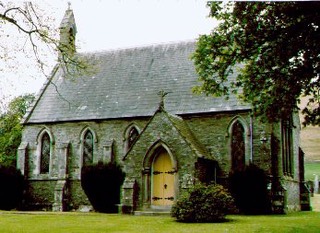The plan was to build a layout based on the Waverley Route from Carlisle to Edinburgh but as if the line had been built, as originally planned, through the valley to Langholm rather than Newcastleton.
I began to draw up plans in 1995 whilst my first layout was still being worked on. Various designs were considered but all based on a dumbbell layout. In fact 12 different arrangements were drawn up in full with varying degrees of complexity before a final plan was settled on.
The final plan was to be N gauge with both ends of the dumbbell in the same corner.
 The lower level would be a return loop with storage loops to represent Carlisle. The train would emerge to cross over a double track Riddings Viaduct before entering Canonbie Junction station. It is this station which formed phase 1 and which I eventually built, though this was the only stage to be completed. At Canonbie there was a junction to Gretna. The main line continued up Ewes date to Langholm where there would be a good sized double track through station rather than the single track terminus which existed in reality. Passing some mills the track would continue up the valley and I hoped to model Ewes Church before entering the loop at the other end representing Hawick. Being a dumbbell it would be possible for the train to run around the loop and come back for the journey in reverse on the down line. In all the track would do two loops of the layout.
The lower level would be a return loop with storage loops to represent Carlisle. The train would emerge to cross over a double track Riddings Viaduct before entering Canonbie Junction station. It is this station which formed phase 1 and which I eventually built, though this was the only stage to be completed. At Canonbie there was a junction to Gretna. The main line continued up Ewes date to Langholm where there would be a good sized double track through station rather than the single track terminus which existed in reality. Passing some mills the track would continue up the valley and I hoped to model Ewes Church before entering the loop at the other end representing Hawick. Being a dumbbell it would be possible for the train to run around the loop and come back for the journey in reverse on the down line. In all the track would do two loops of the layout.
Only stage one was ever built with additional boards to allow a continuous run with storage sidings behind. This stage with the extras was roughly 7 foot 6 inches by 2 food 9 inches. The track ran reasonably well although not without some troublesome points. I used PECO finescale track and came to the conclusion that some of my rolling stock was really not good enough for this.
The layout electrics were quite complex and largely completed but I made the decision to go digital. This was probably a mistake because, although it is possible to modify an existing layout, I think I really needed to change the wiring. The points (turnouts) have not been modified in the way they should which made them more vulnerable to shorting and it would have been better to install circuit breakers so that if an engine shorts the whole layout does not stop. Whilst running on a test track I found the digital quite satisfying the digitised layout produced considerable frustration.
In addition although I have always enjoyed the ability to get a lot of layout in a small space with N gauge I have found the size at times a bit too fiddly. Further, N gauge digital is quite limited at present and whilst new things may come with time I think it
Having all but completed the first stage I experimented with OO digital and this convinced me to switch. There are many advantages with N, including the ability to get a good layout in a small space, but after 20 years of modelling it I have found it frustrating at times and the appeal of OO with digital sound and lights and excellent slow speed running to be too much of a temptation. I still had my old equipment from when I was lad but apart from some scenic items I do not think much of this will be used. Of course the electrics, and in particular the DCC system from the old N gauge layout have been salvaged.
Canonbie Junction layout was dismantled in early 2009.